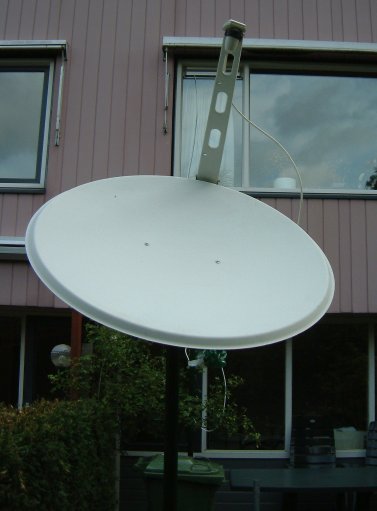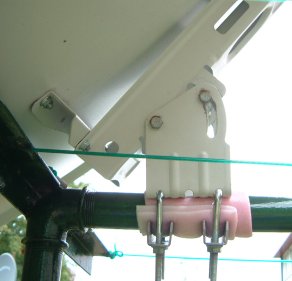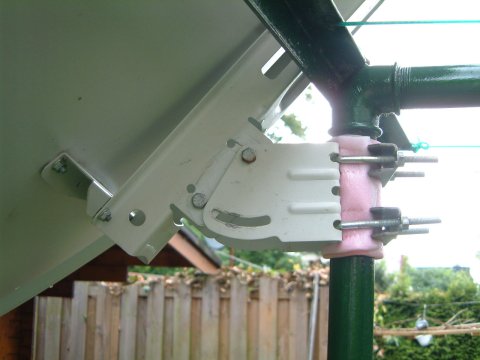First thought: Cutting-edge dishes
My first thought was that the curved shape of the dish is what makes it work, and that its area is merely intended to collect enough signal. The shape of a dish is designed to reflect the parallel beam of satellite radiation in the LNB (the pickup device) where the waves are synchronous, so they don't cancel each other out.
So, I thought, let's buy a very large dish and cut a rectangular section from its middle. This would give an almost-rectangular shape and still the desired properties at the LNB. But the cutting itself was a major concern -- how to do this in a way that would preserve the shape of the dish, and how to bend the sides to attain the desired structural resilience?
The problem with this approach is that the dish gets its physical strength, and thus its stiffness, from the sides which are bent over. Without these sides, the dish would probably not confront winds with a stiff upperlip; but a dish that twists with every breeze is not going to work in the Netherlands! I calculated that the wavelength of the 12 GHz satellite signals is 25 mm, making it acceptable to have 3 mm swing in either direction, but beyond that, the signal really degrades.
In short, this did not sound like a very practical plan.
On second thought: Reflect the dish!
Then I realised that the traditional dish setup reflects the signal downwards, but that it could also be reflected backwards. This would mean that the dish would be mounted almost horizontally, instead of vertically, and it would thus be more flat and easier to hide on a flat rooftop. The LNB (the pickup device) would be mounted at the back, and basically hang over the almost-flat dish.

A simple explanation of the math behind this experiment is in place. I will stick to a practical discussion here.
Imagine a line from the satellite to your dish. This is the path travelled by the signal from the satellite. What the dish does is pickup a parallel beam oriented in that direction, and reflecting it all to one small pickup device, the LNB.
The classical setup is to have the LNB mounted in the lowest point under the center of the dish. The dish and LNB are usually aligned to make this result in almost-vertical dish position. This is the position where it is most visible to passers-by!
It is possible however, to mirror the dish in any plane that goes through the line between the satellite and the dish. If you want to track two satellites, then the plane in which you can mirror is determined by the two satellites and the dish. Any other satellites on that same plane can be picked up just as well. This is especially pleasant because satellites are usually lined up in a geostationary orbit over the equator. In other words, you can receive multiple satellites with this setup just as well as you could before.
Keep in mind that this is mirrorring and not rotating. If you mirror your three-Astra setup you would need to mirror your three-LNB lineup with respect to the arm that carries them. If you mirror an LNB which is rotated 9 degrees left from the vertical line, you will have to rotate it to 9 degrees right from the "vertical" line.
Satellites in a geostationary orbit are elevated about 30 degrees over the horizon, when seen from the Netherlands. This would mean that mirrorring the dish leaves it at an angle of 30 degrees with the ground. As a result, the dish would be half as high as in its vertical placement. Put this in the middle on top of a flat roof with sides that elevate 30 cm above the roof surface, and it is virtually invisible from the ground! (And even from the first floor, which is lucky because the houses in my neightbourhood have their living rooms on the first floor.)
Test setup
I made a test setup for this idea, as shown in the photos below. The satellite tracker device that I used does indeed indicate that I am picking up a satellite, but there are a few problems in this test setup.




As can be seen, the dish is at an angle of about 35 degrees with the horizontal plane. Note that the area as seen from the satellite remains the same, the signal is only reflected to another side.
As the photos also show, there are two problems with this setup. The first is the tree in front of the dish, which blocks the signal from the satellite. This is unpractical during tests, but once the dish is mounted on my rooftop it is not going to be a problem.
A second problem is more serious. The mounting equipment for a dish is made to allow rotation around a vertical axle. This axle has now become a horizontal axle, and as it happens my laundry line is not lined out with any of the Astra satellites. People tend to overlook such things when they punch those laundry line guides into the ground ;-)
To compensate, the dish had to be tilted sideways, thereby distorting the reception of the signal because it is now projected slightly beside the LNB. Using my satellite tracker device, I can hear the signal level going up and down a few times while I slightly move the dish in either direction. The fluctuations appear to have spots where the signal locally cancels out, which probably indicates wave interference.
Installation support
It would be good if this setup were as simple to tune as a standard setup. As it turns out, there still is a problem to be solved.
For the normal/vertical setup, the first step is to tilt the dish under the right angle with the horizontal plane. After this is done, the dish can be rotated around a vertical axle to select the desired satellite from the lineup floating over the equator. This works so well that there exist dish rotator devices to dynamically switch between satellites.
To make this setup work with the same clamps as on a standard dish, a similar order of working is needed. One approach would be to make a bent axle onto which the dish would be mounted (almost) horizontally; the axle would support rotation as instructed by a dish motor or a worker moving the dish during installation. This way, the tilting problem in my test setup would be avoided. But a simpler solution is often possible.
Looking at the closeup below of the mounting bracket of the dish, it is noteworthy that the screws behind the dish are at an angle of about 45 degrees. In other words, it ought to be simple to flip the mounting bracket around and change the horizontal axle into a vertical axle. I hadn't taken the dish apart up to now.

This sort of flip-over should be possible with most of the satellite mounting brackets. After the flip-over the dish can be mounted on any vertical axle, either fixed or motorised or full of laundry.

Et voilá! The interference is gone, so aiming the dish now works just like aiming it in the normal setup. The only problem remaining is the tree that is still in the way of good reception. Since this is just a test setup, I used a broom to swing the branches aside (a typical lab experiment procedure...) and got instant signal improvement and channel recognition on the tuner.
This mounting method is roof-ready!
 Vertaal naar het Nederlands
Vertaal naar het Nederlands